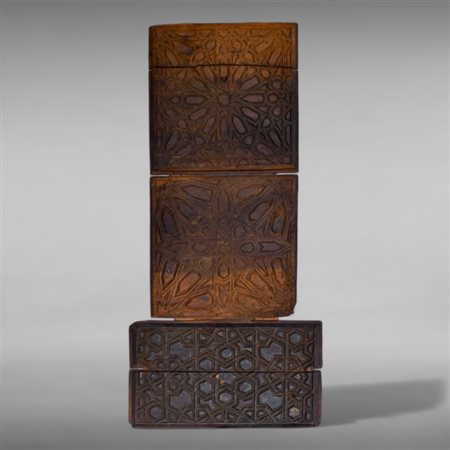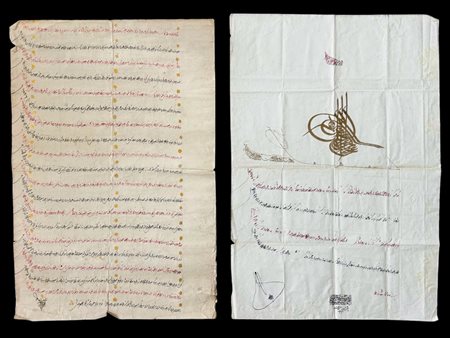Pre-Asta Islamic and Indian art from a Private Collection in Rome and other provenances. In partnership with BAIAS Arte.
-

Lotto 49 A carved wooden panel
Egypt, possibly 18th century
Rectangular panel, probably originally part of a door or a plaque, the front divided into three compartments, the larger central one carved with geometric inlays bordered by bone inlays containing interlaced arabesques. Split palmettes carved within a rectangular cartouche bordered with vegetal elements also in the two smaller plaques flanking the central panel.
H. 8.8 X L. 41 X P. 4 cm -

Lotto 50 A composite wood panel
Morocco, 19th - 20th century
Composed of three plaques, one of which is double, of different wood types, carved with geometric stars of different sizes. Similar decorations are common in Spain and North Africa, especially on wall decorations of tiles forming kaleidoscopic compositions such as these.
H. 91 X L. 43.5 cm -

Lotto 51 Two Persian papier maché pen cases (Qalamdam)
Iran, 19th - 20th century
Two pen holders of different sizes, the smaller decorated en grisaille with flowers and birds on a beige background, signed and dated 1321 AH (1942 AD). The larger painted with a figurative motif and inscription in Persian within lobed cartouches.
H. 6.5 X L. 36 cm (the largest) -

Lotto 52 Two tubular inkwells (Kubular)
Persia and Tibet, 19th - 20th century
The Persian one made of brass covered with cardboard decorated with floral motifs, cloud bands and signed 'Soltani'. Domed stopper covered with mother-of-pearl micro-tiles. The other of embossed silver, decorated with Buddhist emblems and set with coral.
L. 32.5 cm (the largest) -

Lotto 53 A wood and mother-of-pearl inlaid penholder
Turkey or Northern Iran, 19th century
Rectangular scribe's accessory, with a hinged and flip-top lid, decorated with abalone inlays with interlaced arabesques on three sides and an inscription reading bismillah on the lid.
L. 27 cm -

Lotto 54 A Persian marquetery khatamkari box Qajar
Iran, 19th century
Rectangular, decorated with the khatamkari technique involving micro inlays of bone and metal. The box opens in two equal halves. Long poetic inscription (verses from the poems of Hafez) written in nasta'liq script on the lid and within a cartouche above the clasp.
21 X 66 X 25 cm -

Lotto 55 A wooden inlaid calligrapher's chest
Ottoman Empire or India, 19th century
Rectangular with central drawer with metal fittings. The exterior with bone and mother-of-pearl inlaid decoration of vases of flowers arranged within large cartouches with corner decoration. Each side bears a six-pointed star inlaid with mother-of-pearl. The drawer shows an inscription in Arabic characters that reads: Ya Fattah (the One who opens), Ya Razzaqh (the One who feeds), ... Vassalamah (salutation).
35.5 cm X 68 cm X 35.5 cm -

Lotto 56 A wood and mother-of-pearl inlaid scribe box
Probably India, Gujarat, 17th century
Wooden desk accessory inlaid with mother-of-pearl forming intertwined split palmettes on the sides. The hinged, flip-up lid is decorated with bismillah in the nasta'liq calligraphic style flanked by two eight-pointed stars. The nailed inlay technique of the mother-of-pearl is typically Indian and the Islamic and Persian-style calligraphy place the object in the production of the sultanates of the subcontinent. For comparison cfr. Skelton R., The Indian Heritage, Court Life and Arts under Mughal Rule, Londra, Victoria and Albert Museum, 1982, cat. n. 549 p. 162. Another similarly decorated pencase is treasured at the David Collection, Copenhagen, Acc. no. 35/1976
31 X 8.5 X 9.3 cm -

Lotto 57 Three pairs of calligraphy scissors
Ottoman Turkey, 19th century
Steel scribe's accessories; one has lost its gilding but the floral housings are visible, one is encrusted in gold leaf with plant decorations and the last one has no decoration.
L. 24 cm the largest -

Lotto 58 A brass Pencase (Qalamdan)
Probably Anatolia, 19th century
cast brass with rectangular pen case and ink holder in a rounded and slightly flattened shape with hinged lid. The exterior decorated with plant motifs and a long Armenian inscription on the depth of the item.
L. 26 cm -

Lotto 59 Two illustrated folios by a Shahnameh
Safavid Iran, possibly Qazvin, 16th century
Persian text on paper, written with black ink in nasta'liq calligraphy and arranged within four columns interspersed with illustrations. One depicting Khosrow; the other depicting Kaku's arrival at the fortress of Hokht Gang Bayani Salam and his death at the hands of Manouchehr.
Damage and restoration.
21 X 13 cm circa (senza cornice) -

Lotto 60 Ottoman Firman with Thughra of Mohmoud II (r. 1808-1839)
Ottoman Turkey, early 19th century
Turkish text on paper, 12 lines in chancery script (diwani) written in black ink on a single column and surmounted by the Sultan's cipher.
H. 78 X L. 51 cm -

Lotto 61 Long Ottoman Firman in two fragments
Ottoman Turkey, 18th or 19th century
Turkish text on paper, 24 full lines of text, in addition to the incipit, written in black and red ink in diwani calligraphy, verse markers in the form of gilded discs and surmounted by thughra probably from Sultan Abdulhamid II (r. 1876-1909). A stamp related to Waqf (institution of religious charity) is printed on the lower portion of the fragment with thughra, dated 1310 AH (1892 AD).
H. 154 X L. 55 cm -

Lotto 62 Illustrated folio with reproduction of Aghia Sophia
Turkey, 20th century
Text in Arabic on the front and Turkish on the back. The front shows a depiction of the most important mosque in Istanbul, a former Byzantine basilica, on a background of minute golden spirals. The text on this page is of a religious character and is a prayer for the victory of a war, which is narrated on the verso, in Turkish, black ink on a single column of 13 lines. The miniature was exhibited at the Musée d'Art Moderne Céret, France, during the exhibition Najia Mehadji, la trace et le souffle, 30 June-4 November 2018.
19.5 X 13.5 cm -

Lotto 63 Drawing depicting an elephant Mughal
India, early 18th century
China on paper, depicting an elephant in captivity and three Mahouts tending it.The Mughal court's fascination with 'exotic' animals is well known, particularly during the Akbar period. Elephants were part of this context and were used for heavy loads and for agricultural work. As a symbol of power, they were means of transport for important people during celebrations and parades, and finally they were trained to perform acrobatics during games. Within a yellow marble frame.
32 x 54 cm (light 20X39) -

Lotto 64 Ottoman Qur'an
Turkey, 19th century
Arabic text on polished paper, consisting of 272 folios, complete. Double frontispiece (sarlaw) illuminated with flowers and sprays on a cobalt blue background and text within a circular cartouche with gilded spacing. Writing box 150 X 87 mm bordered by gilt fillet, containing 15 lines to the page, written in Naskh script with black ink and red diacritics. Verse separators (ayat) in the form of gilded rosettes, section separators with hanging floral medallions and Sura titles in reserve on gold. Reclamantes in margin. Impressed leather binding with flap.
21.5 X 14.5 cm -

Lotto 65 A large Qur'an
Kashmir, 19th century
Arabic text on paper. Double frontispiece (sarlaw) in typical Indian style with arabesques on a blue background within repeated gilt cusped arches. Writing box 198 X 103 mm bordered by triple red and blue fillets and containing 11 lines of text penned in Naskh script in black ink and red diacritics. Verse (ayat) separators in the form of golden rosettes, circular section separators with pendants and Sura titles in red ink. The opening of some juz (parts of the Qur'an) decorated with floral illumination in the margins and gilded spacing. Notes in margins in red.Red leather-covered cardboard flap binding.
H. 28 X 17.2 cm -

Lotto 66 Two lithographs depicting Istanbul
17th - 18th century
Two engravings depicting Istanbul in 'bird's eye' view. One of them probably of French production, coloured; the other with extensive description in Latin.
cm 27x39
cm 29x40 -

Lotto 67 Diwan-i. Book of poems signed Muhibbi, pseudonym of Suleiman the Magnificent
Istanbul, Matba'a-ï 'osmâniye, 1308 AH (1891 AD)
Text printed in Ottoman Turkish, composed of 236 pages. Red leather flap binding printed with plant motifs filled with silver, partially oxidised, finishing. First printed edition. Owned by Rudolf Tschudi with autograph note of ownership. Suleiman the Magnificent was also a passionate poet and used the pseudonym Muhibbi in his literary works.
28 X 17,5 cm -

Lotto 68 Preziosi, Stamboul Moeurs et Costumes
Paris, Canson, Libraire - Éditeur, 1883
Part of the Encyclopaedia of the Decorative Arts of the Orient. Large folio, incomplete, consisting of frontispiece, index and 17 colour lithographs illustrating the traditional customs of Istanbul, all contained within original cloth-covered cardboard folder. Inside showing Ex Libris from the Emil & Helene Jaensch collection. An Orientalist painter originally from Malta, Amadeo Preziosi (1816- 1882) arrived in Istanbul at the end of 1842 and lived there until his death in 1882. He became famous as the painter who reflected contemporary life in Istanbul. He was also employed as court painter during the period of Abdulhamid II.
67 X 48 cm -

Lotto 69 Cornelius Gurlitt, Die Baukunst Konstantinopels
Berlino, Verglegt bei Ernst Wasmuth A.-G., 1912
Collection of ca. 100 sheets with photographic plates and architectural plans of the main monuments of Constantinople.
51 X 36 cm -

Lotto 70 L'empire Ottoman illustré - Constantinople Ancienne et Moderne Fisher Fields and Cie
London and Paris, undated (c. 1838)
Three volumes bound in gold stamped leather, fine edition of the work by Lèon Galimbert and C. Pellé, contributors to the British magazine, illustrated by Cav. Thomas Allom. Each volume contains 32 black and white plates, protected by tissue paper.
H. 28.5 X 22 cm -

Lotto 71 Three panoramic photographs of the Bosphorus
c. 1900
Including: A view of Istanbul from the Galata Tower; a view of the Bosphorus from Roumeli Issar and a view of the city showing the Galata district. Black and white photos, produced by the Ludwigsohn brothers, Karakeuy Square 21 Istanbul.
H. 9 X l. 110 cm (the largest) -

Lotto 72 City view and a view of the port of Constantinople
Augsburg and Paris, 18th century
Perspective view of Istanbul made in the style of an optical veduta typical of Georg Balthasar Probst (1732-1801). The other a picturesque view of the city harbour taken from the north coast.
cm 32x44
cm 26x40
